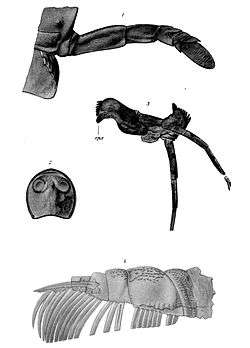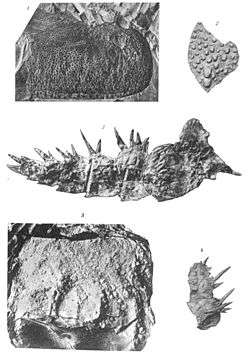Echinognathus
| Echinognathus Temporal range: Ordovician | |
|---|---|
 | |
| 4: type specimen | |
| Scientific classification | |
| Kingdom: | Animalia |
| Phylum: | Arthropoda |
| Subphylum: | Chelicerata |
| Class: | Merostomata |
| Order: | †Eurypterida |
| Superfamily: | †Megalograptoidea |
| Family: | †Megalograptidae |
| Genus: | †Echinognathus Walcott, 1882 |
| Species | |
| |
Echinognathus is a genus of prehistoric eurypterid in the Family Megalograptidae. Echinognathus is known from the Ordovician.
Description

Megalograptids were characterized by large exoskeletons with ovate to triangular scales. The prosoma (head) was subquadrate, with a tonguelike anterior process bearing marginal spines, and compound eyes on the top front of the head. The chelicerae (claws in front of the mouth) were small and short. The first and third pairs of walking legs were short, with diverging or closely spaced spines. The second pair of walking legs was enormously developed, with long paired spines. The fourth pair of walking legs was nearly spineless. The preabdomen, the front portion of the body, was narrow with axial furrows, while the postabdomen was moderately narrow with broad, flat and curved appendages on the last body segment. The telson was short and lanceolate.[1]
Echinognathus is distinguishable from other members of the family by the third walking legs, which are characterized by long, closely set spines.[2]
See also
References
- ↑ Størmer, L 1955. Merostomata. Treatise on Invertebrate Paleontology, Part P Arthropoda 2, Chelicerata, P36.
- ↑ Størmer, L 1955. Merostomata. Treatise on Invertebrate Paleontology, Part P Arthropoda 2, Chelicerata, P36.